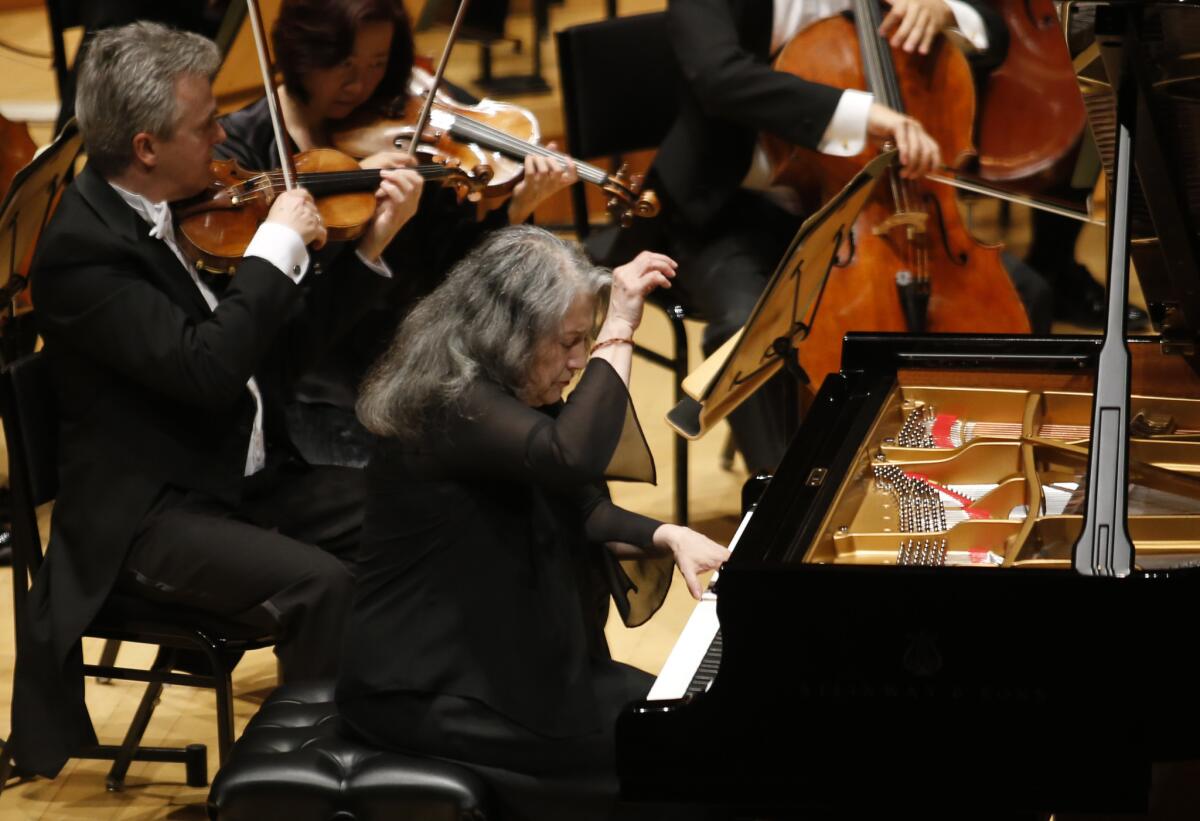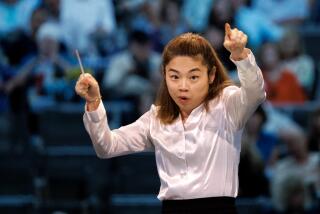Review: Martha Argerich mesmerizes the L.A. Phil

- Share via
Her daughter calls her, in a recent documentary, a goddess. And the audience at Walt Disney Concert Hall on Thursday night was not about to disagree when Martha Argerich walked on stage to play Schumann’s Piano Concerto with the Los Angeles Philharmonic.
The Argentine pianist, perhaps the most lionized soloist on the current circuit, has a reputation for canceling. That hardly prevents her from selling out the house; her fans buy tickets knowing they may be taking a chance. But she seemed to acknowledge all that with a disarming, well-here-I-am-in-the-flesh look.
Some in the hall stood quietly, almost reverentially, as if her entrance were a marvel before their eyes. Others cheered and whistled loudly from their seats, practicing a more conventional acknowledgment of celebrity. Either way, a sense of awe pervaded the room before a note was played.
SPECIAL PROJECT: Inside the L.A. Philharmonic
The awe endured. There is more gray in her long, thick hair than when she last appeared with the L.A. Phil six years ago, but at 73, Argerich has lost nothing of her fleetness of touch at the keyboard or her mercurial manner. She has played the Schumann concerto hundreds, if not thousands, of times. It is one of only a handful of concertos she tends to play these days.
But that doesn’t mean you know what to expect. This night was no exception.
The revelation in Stéphanie Argerich’s film “Bloody Daughter,” however intimate and personal the documentary is, is that there is no revelation: Argerich is a pianist who remains unknowable. She answers questions in ways that seem truthful and revealing yet evasive. At a rehearsal, she can be seen trying out a phrase in a Chopin concerto one way, then another, then another. All sound right. All sound like only Argerich could make them sound.
Ultimately, Argerich comes across as many contradictory things at once, without any of them being contradictions. If physics tells us a wave and a particle can be the same irreconcilable phenomenon, she represents the same thing in a pianist.
Argerich responds in performance to the situation, to the conductor, the orchestra, the room and maybe other things we don’t know about. Her conductor was Juraj Valcuha, a Slovakian in his late 30s who made his L.A. Phil debut at the Hollywood Bowl in 2009. He led an aggressively chiseled, ear-popping performance of the Four Sea Interludes from Britten’s opera “Peter Grimes” to begin the program and Strauss’ “Death and Transfiguration” to end it.
But he was putty in her hands, as was the orchestra. Schumann’s concerto opens with an orchestral salvo — a single, punched chord — which acts like a bolt of electricity to shock the piano into action. It was Valcuha’s one big moment (or, more accurately, second). From them on, Argerich operated the electricity.
Ever the ideal of duality, she was here both an impulsive player who sent sparks from the piano and a marvelous lyricist who shaped a melodic phrase with utmost suppleness and a tone so luminous it all but glowed in the dark.
There were two sides of her immediacy. She controlled the performance while interacting with the orchestra as though it were making chamber music. She reacted to and urged on the most subtle and personal melodic nuances. At times it might have been only she and the oboe, or only she and the clarinet, in intimate dialogue.
The conductor was free to follow along as Argerich made Schumann’s slow movement seem like a familiar yet ever renewable romance (the composer wrote the concerto as a valentine to his wife). In the Finale, Argerich captured the spirit of dance. Her encore was Schumann’s “Traumes Wirren” (Dream’s Confusion) from his “Fantasiestück,” played fast and light and seeming to float through space.
Valcuha was more adamant and down to dramatic earth. The sound he got from the orchestra reminded me of old analogue tape machines. If you played a tape encoded with Dolby noise reduction with the Dolby switched off, you heard penetrating detail but the timbres were grainy.The result was striking, although the harshness could give you a headache after a while.
For “Grimes,” a fisherman’s tale, Valcuha offered the sensation of sea sickness. In Strauss’ tone poem, the soul left the body with a shocking, exhausting violence, and heaven was in Technicolor.
More to Read
The biggest entertainment stories
Get our big stories about Hollywood, film, television, music, arts, culture and more right in your inbox as soon as they publish.
You may occasionally receive promotional content from the Los Angeles Times.











